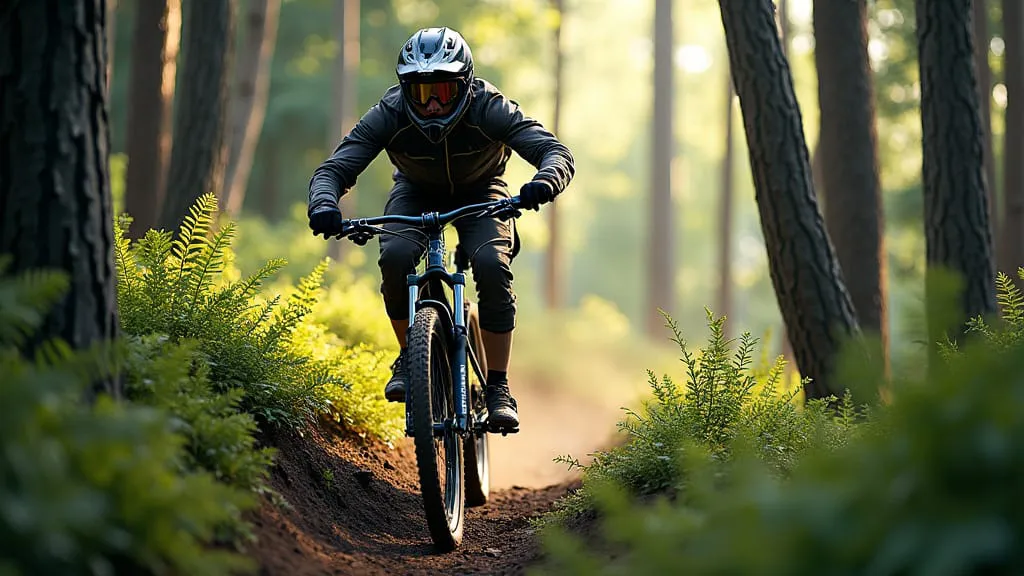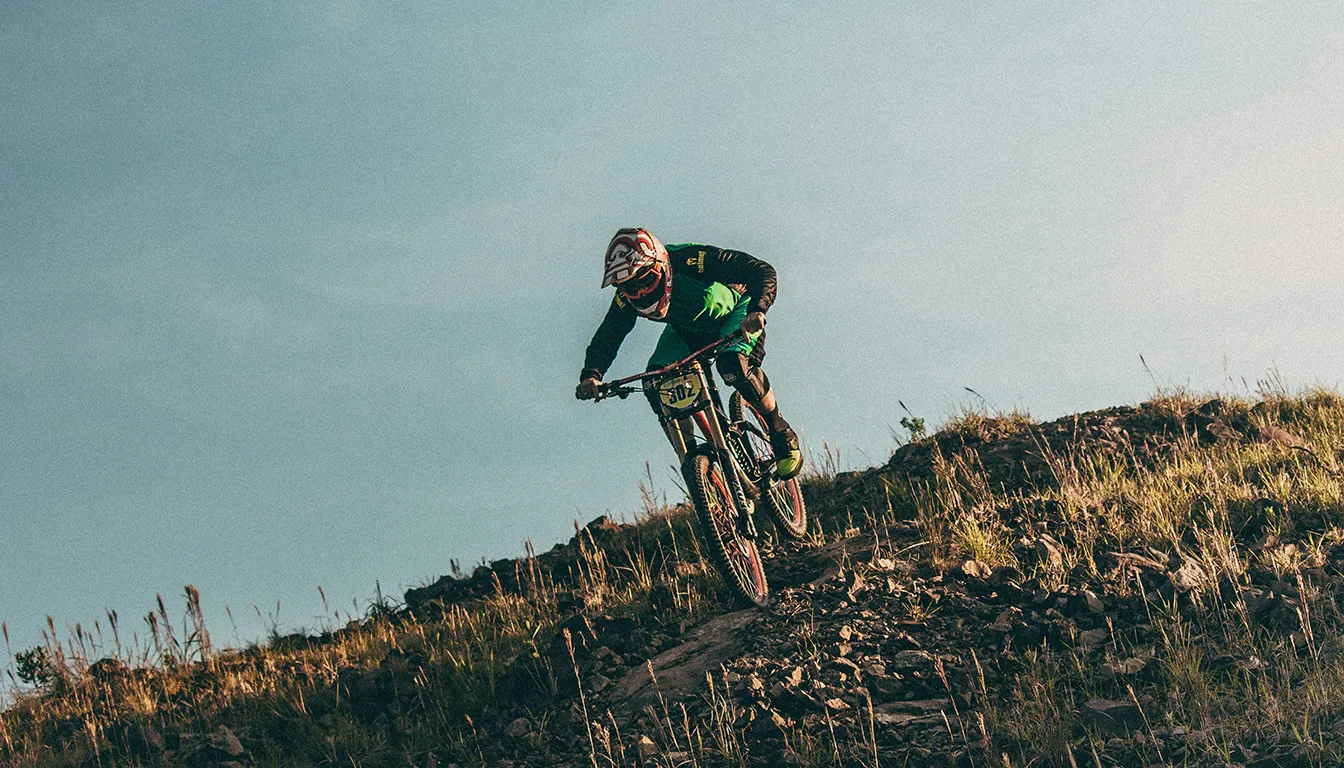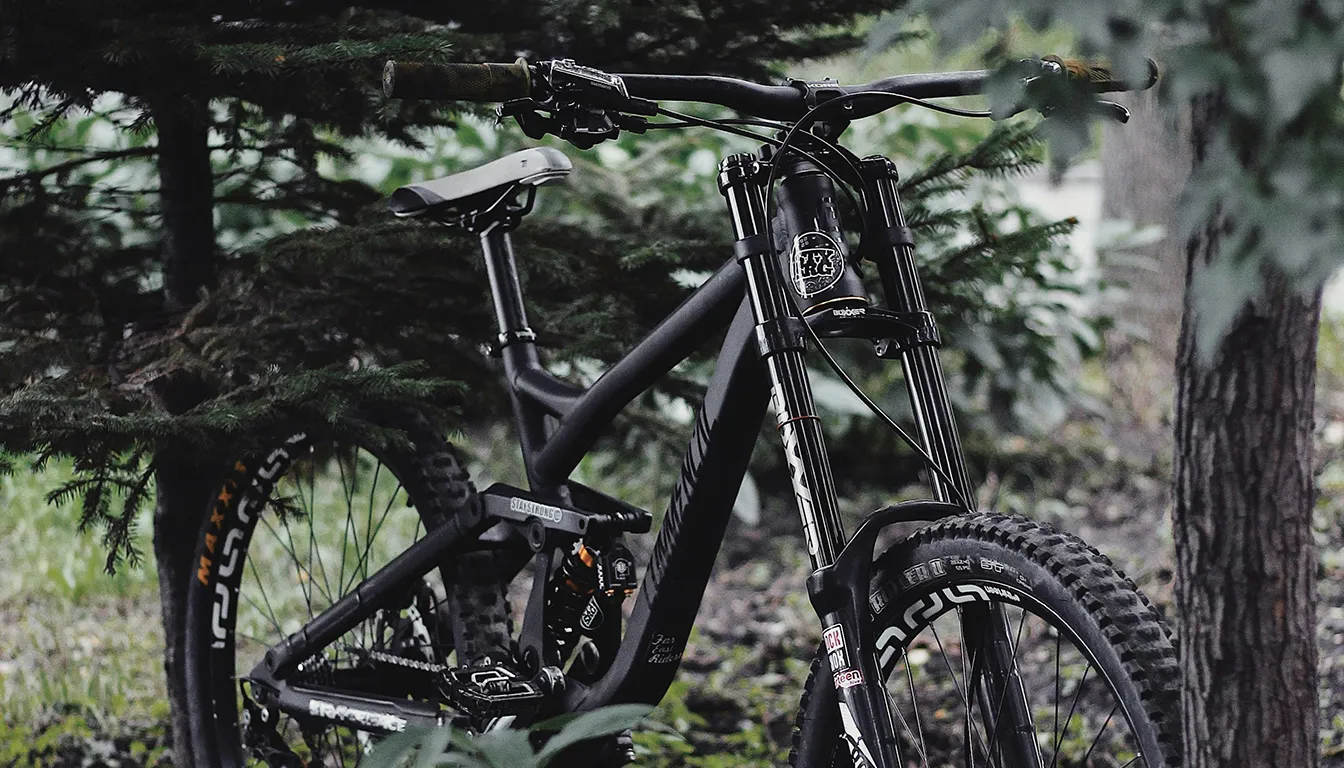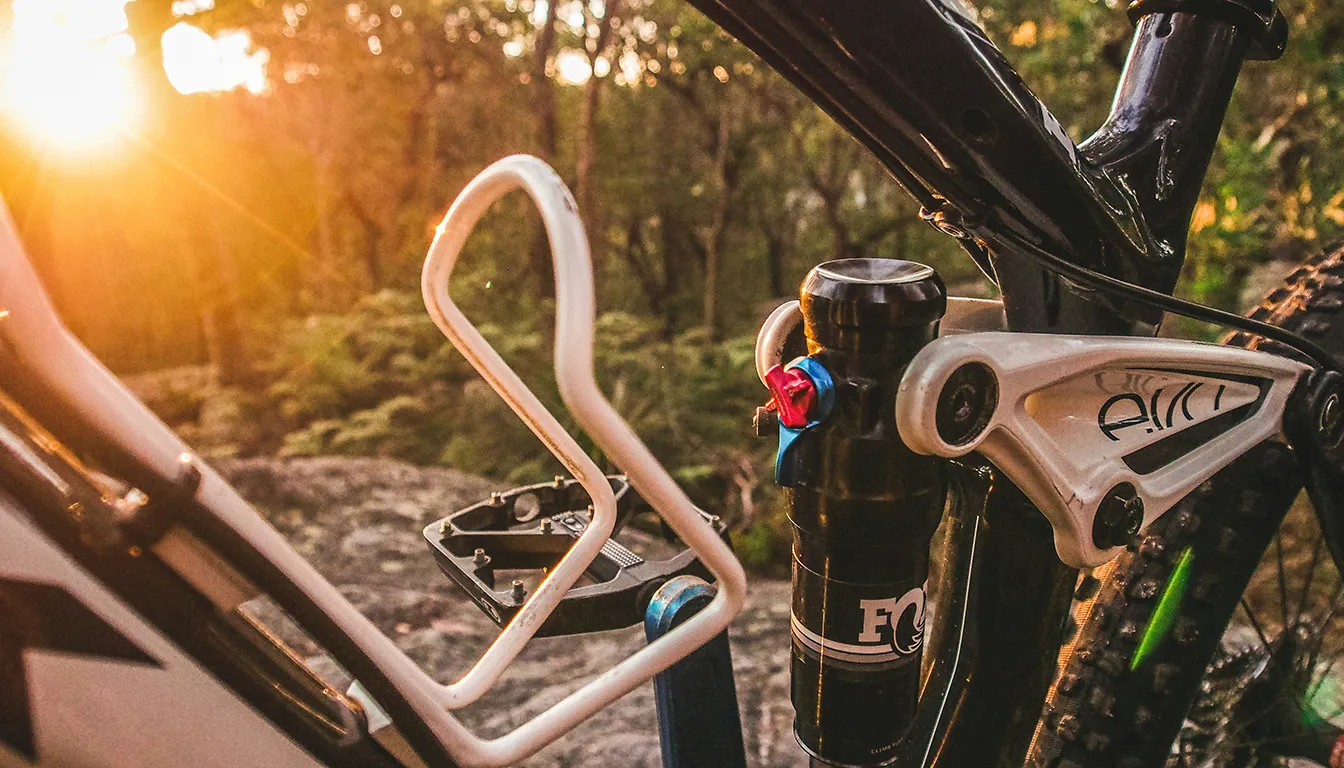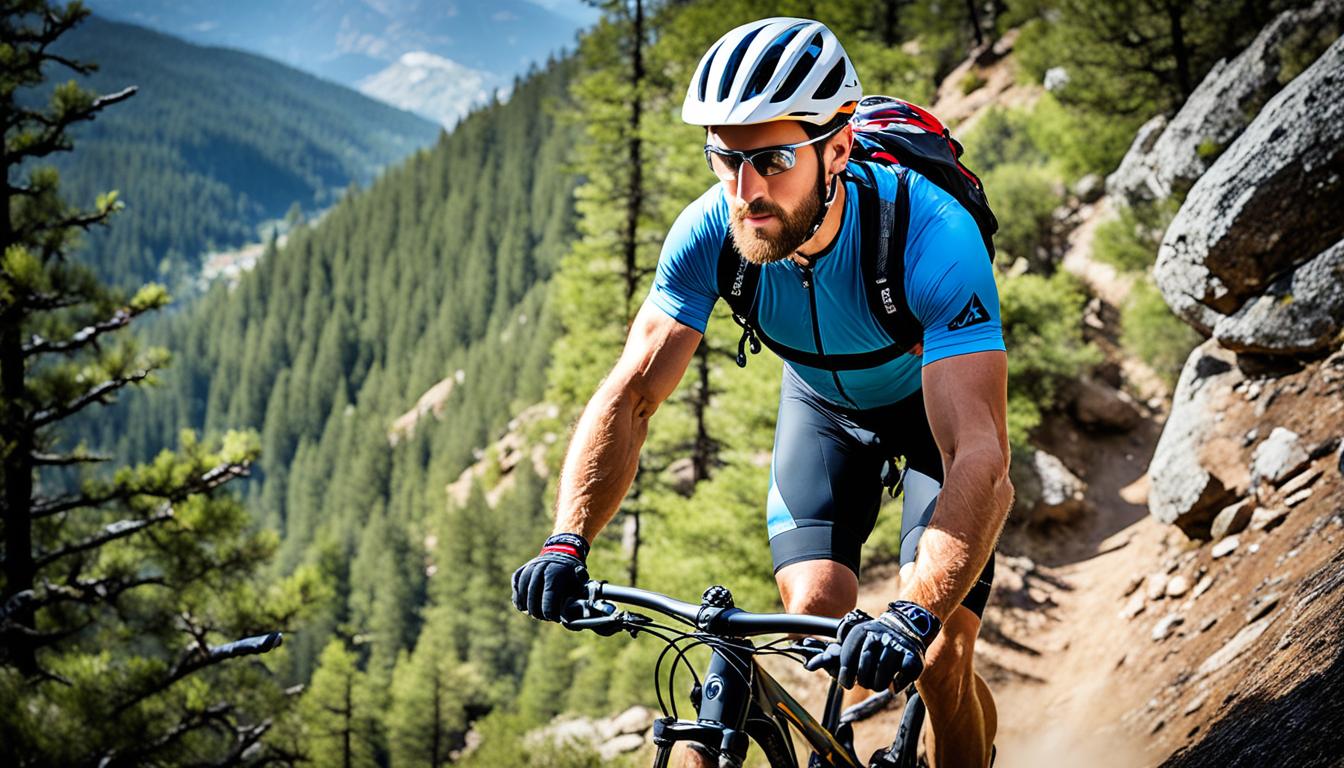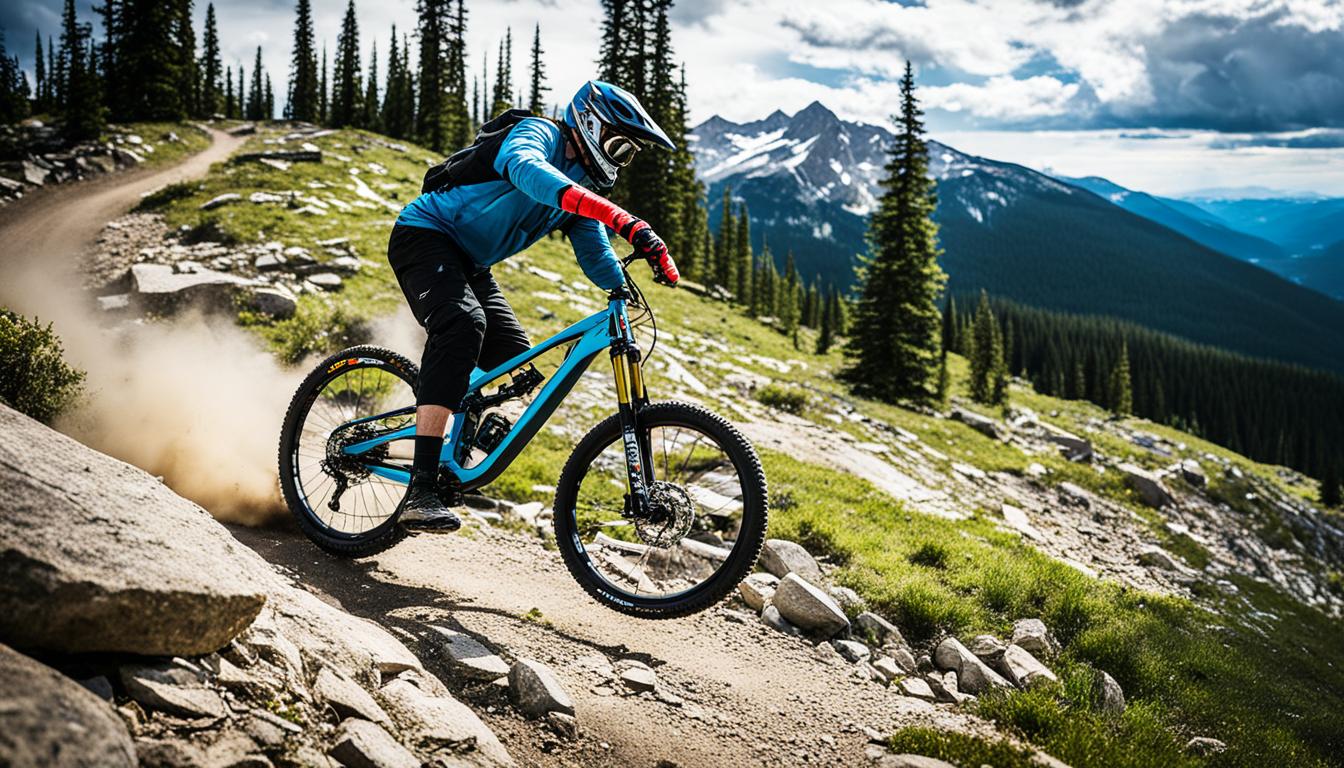Downhill mountain biking is thrilling, much like the high speeds of Formula 1 racing. Yet, safety is crucial for fun and avoiding injuries. This piece gives vital tips for both new and seasoned riders. It covers basics and gear knowledge to lower downhill biking risks. Learn the right bike set-up and how to stay focused on the path. These tips ensure you ride through tough trails with ease.
Want to boost your skills and self-assurance on the bike? Explore these key riding tips. They’re made for both beginners and pro cyclists.
The Thrill of Downhill Mountain Biking
Downhill mountain biking is an exhilarating sport, marked by fast speeds and exciting jumps. It gives riders an adrenaline rush that’s hard to forget. This discipline is a special part of mountain biking. It attracts riders with its mix of technical skills and thrilling experiences.
Understanding the Downhill Discipline
This discipline is all about the adrenaline. It’s perfect for those who love intense challenges. It involves steep terrains and rough trails. Riders need excellent balance and control. The thrill comes from facing jumps and sharp turns. These elements make the ride an adventure. Riders also compete in events, brining adrenaline junkies from all over the world together.
History and Evolution of Downhill Bikes
Downhill biking started in the 1970s with riders using modified “klunkers”. The 1990s saw a big leap in mountain bike technology. This period introduced bikes with dual-crown forks and advanced suspension. This made the bikes safer and performed better on tough trails. The first UCI Mountain Bike World Championships in 1990 was a key event. It made downhill biking known worldwide.
Year by year, more riders join the sport, eager for new adventures and challenges. The development of mountain bikes has changed downhill biking a lot. Today, it offers even more excitement and tests for the riders.
| Era | Key Innovations | Impact on Discipline |
|---|---|---|
| 1970s | Modified klunkers | Foundation for mountain biking |
| 1990s | Dual-crown forks, advanced suspension | Enhanced speed and safety |
| 2000s and beyond | Carbon frames, disc brakes | Improved performance and agility |
Essential Bike Set-up for Downhill Riding
The right bike set-up makes a big difference in downhill mountain biking. It’s crucial to pick wisely for comfort and safety on tough trails. Here are important points for the best ride.
Choosing the Right Downhill Mountain Bike
Choosing the right frame size is key when picking a downhill mountain bike. Consider your height and weight to find the perfect fit. Learn about bike features like suspension and wheel size for a better ride. Big 29″ wheels offer stability and 650b wheels are good for quick moves.
Adjusting Your Bike for Optimal Performance
Making the right bike adjustments is essential. The seat height should let you ride comfortably but powerfully. A good fork setup, with stanchions of 40mm or more, provides control on steep paths. Play with tyre pressure for the best grip based on the terrain. Adjusting handlebars and brake levers makes rides easier. For tips on safe riding, check this resource.
| Bike Feature | Importance |
|---|---|
| Frame Size | Ensures proper fit and control. |
| Wheel Size | Affects stability and performance on various terrains. |
| Suspension Travel | Critical for absorbing impacts and improving grip. |
| Tyre Pressure | Optimizes traction and ride comfort. |
| Brake Setup | Enhances safety and stopping power. |
How to Ride a Downhill Mountain Bike Safely
Riding downhill is exciting, but safety is key. You need to know several techniques. By focusing on your body position, preparing for terrain changes, and using brakes safely, you can make your ride safer. Learning these skills allows you to enjoy going downhill while staying safe.
Mastering Your Body Position
Having the right posture is crucial for control on downhill paths. You should keep your body centered with your knees and elbows slightly bent. This position helps you stay stable on rough terrain. Also, shifting your weight towards the bike’s rear improves grip and helps you handle bumps better.
Always adjust how you sit based on the slope and obstacles. This helps keep you balanced throughout your ride.
The Importance of Anticipating Terrain
Being able to anticipate the terrain is key for downhill biking. Watching the path ahead helps you prepare for things like sudden drops or rocky areas. Being ready for what’s coming makes you react faster and ride better.
Riders should keep an eye on the trail to spot hazards early. This makes it easier to change how you’re riding or your speed quickly.
Braking Techniques for Safety
Safe braking is vital for keeping control while going downhill. You should brake with one finger to keep pressure steady without overheating the brakes. Remember, when you go faster, it takes longer to stop, especially on wet ground.
Adjust your position by leaning forward to use the front brake better on steep sections. Also, cool your brakes by stopping now and then to prevent them from overheating.
If you’re a beginner or going to bike parks, choose a full suspension trail bike. Check your bike’s condition before riding, like tire pressure and brakes. Wearing protective gear like helmets, knee, and elbow pads is important for safety. Learning about the bike park’s lift system is also useful.
| Safety Equipment | Purpose |
|---|---|
| Full-Face Helmet | Protects your head from impacts. |
| Knee Pads | Help avoid injuries during falls. |
| Elbow Pads | Protect your arms from scrapes. |
Understanding these techniques well makes downhill riding safer. Keep practising to get better and safer at it. For more tips on improving, check out essential mountain biking advice.
Perfecting Your Riding Techniques
Mastering riding techniques is key for both safety and fun in downhill mountain biking. Good cornering is important for control on different terrains. Riders should start corners wide for a smoother turn. This helps keep the bike stable and increases exit speed. Improving cornering can make a big difference in riding skill.
Cornering Strategies to Maintain Control
To corner well, keep your body ready and weight shifted back, looking ahead for dangers. Lee McCormack says to push your backside back and bend at the hips. This balance helps you steer better on slopes. Lean your bike into turns to corner better and avoid common mistakes.
Handling Drop-offs and Jumps
Being good at handling drop-offs and jumps makes downhill riding more confident. Make sure to land with both wheels at the same time. This lessens the impact. Keep your weight back and stay flexible when jumping. This prevents accidents. Practising smooth braking and avoiding obstacles is key to mastering downhill paths.
FAQ
What are the essential tips for safely riding a downhill mountain bike?
To safely ride, know your bike well. Keep the right body stance and plan for the road ahead. Learning bike skills and safety tips makes biking downhill better.
How has downhill mountain biking evolved over the years?
Downhill biking has changed a lot since the 1970s. It started with upgraded ‘klunkers’. Today, new tech like dual-crown forks changed the game. The sport’s big moment was the first UCI Mountain Bike World Championships.
What should I consider when selecting a downhill mountain bike?
Choosing a bike means looking at size, tyre air, and how the bike moves. Match these to your body size and weight. This makes sure you ride well and efficiently.
What are some crucial techniques for riding downhill safely?
Important methods include keeping your body balanced with knees and elbows slightly bent. You should also read the road to keep control. Using brakes well stops them from getting too hot on tough paths.
How can I improve my cornering strategies on downhill trails?
To get better at turning, start wide and lean through the corners while keeping steady. This keeps your speed and control which makes riding smoother.
What techniques should I use for handling drop-offs and jumps?
When doing drops and jumps, line up your body for a smooth landing on both wheels. Lean back and stay flexible when jumping to prevent accidents.
